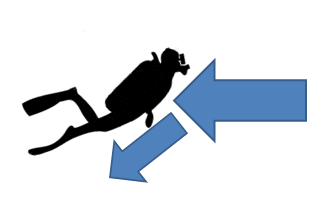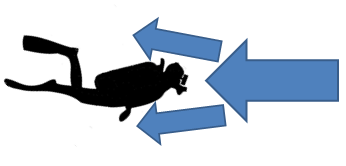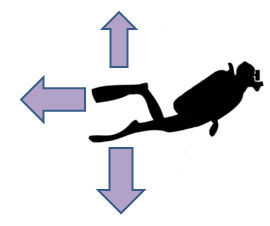Recently I have seen a number of questions posed asking how can people improve their breathing rates aka reduce the amount of gas they use. I find it funny many people suggest options such as breath training devices, taking longer/deeper breaths, concentrating on your breathing, yoga breathing etc. All these work on the premise of addressing the issue of breathing, not the cause of why as a diver you need to breathe. Unless you have difficulty breathing while walking around on land, these are only going to have a small impact on your breathing rate and will take a reasonable time period to show any worthwhile results. What divers need to focus on, is the cause of the breathing, as this will have a greater impact on your breathing rate.
First off, it is good to actually quantify your diving breathing rate, commonly referred to as SAC (Surface Air Consumption) / RMV (Respiratory Minute Volume). I have written a blog on how you can calculate these here:
https://grahamsavill.wordpress.com/2017/07/26/gas-management-and-planning/
As humans on average take around 15 breaths a minute with a lung tidal volume of about 0.5litre when at rest, which is around 7.5 litres a minute. There is a rough formula of Body Weight In Kilo multiplied by 7mililiters to get a better average for your body type. Again these are averages, but will give you an idea.
The graphic below represents your lungs. The red area represents the your residual volume of your lungs once you have fully breathed out and cannot breath out any further. The Blue area represents your tidal volume, this is how much you breath in and out at rest. The Light Blue area represents your Vital Capacity, this is the total amount of air you can breathe in and out of your lungs. The black line represents the capacity you are using when your breathing pattern at rest then progressing on to when you experience exertion.

Second is a quick recap into why as humans we need to breathe, and in the most simplistic form, we need to breath in Oxygen for our organs to work, and need to breathe out carbon dioxide which is a by-product from our organs. The harder our organs have to work the more oxygen they need and the more carbon dioxide they make and need to get rid of. This equals to an increase in breathing rate and depth of breathing. For example compare your breathing sat doing nothing, walking round the house, to running/lifting something heavy. It is actually the level of Carbon Dioxide in our bodies that cause our reflex to breath. This means when you hold your breath, the urge to breath out and in, is not the lack of oxygen but the level of Carbon Dioxide. Free divers in simple terms learn to fight that reflex by building up a resistance to it.
There are 2 areas that make divers breath more, ‘Physical Exertion’ and ‘Mental Exertion’. We are going to have a look at what causes both of these in some more detail and how as a diver you can counter these. The simple formula is, Less Exertion = Less Breathing = Less Gas Used.
It is a very reasonable suggestion to suggest people will improve their SAC rates by just getting out there a diving, which is true to an extent as during those dives they will be unconsciously improving on these two areas. However by being aware of these and working to address them in a structured approach will simply increase the speed of improvements and lead to better results.
Now this is not a complete list, and many things will affect your breathing that are outside your control such as visibility, currents/tides, water temperature etc.
Physical Exertion
One of the biggest causes of physical exertion in divers is drag. As humans we can be fairly streamlined in the water, however once you add on all the scuba gear that becomes a different story. There are 3 areas that greatly effect drag, Weighting, Trim and Kit Setup.
Weighting
Be correctly weighted for every kilo of extra weight you add above what is needed is to be neutrally buoyant, you need to add air to your BCD/Drysuit to counter you sinking. This air displaces 1ltr of water, so if you are 3kg over weighted, that’s 3 extra litres of water you need to move as you move. The issue is then multiplied by many BCDs expanding outwards making them less streamlined harder to move through the water by creating drag. If you are not adding this extra gas to your BCD and you are over weighted, then you will be compensating for the negative buoyancy in your kicking which will cover further down.
Trim
To be the most streamlined in the water you need to be horizontal as you swim, and more importantly when you are stationary. If you are not horizontal when you are stationary ie find yourself naturally shifting to a vertical position (quickly, a very slow shift is fine), 2 things are happening when you swim. 1 your kicking is not effective, in the sense that some of the energy you have put into your kicks is not actually used to move your forward, but is actually being used to bring you into a horizontal position. 2 As you swim forward the water is actually pushing you into trim, which means your body is causing drag. Once you have your weight perfected, look at how you can spread the weight across your body, so when you stop swimming, you stay horizontal (In Trim).

Streamline kit
This is very much about removing as much drag as possible, less drag means less water resistance therefore less effort needed to move forward. One of the key things divers can change is the accessories they carry. When they kit up on the surface, these hang down the body, but as soon as they are horizontal in the water these hang away from the diver increasing drag. Some simple solutions are attaching items to the rear (around your bum) so they are in the slipstream of the BCD/Tank, putting items in pockets, or using bungee loops to hold the item in place. Other measures such as decreasing the length of hoses and securing them against the body can also help. This can also be done with the BCD inflator hose. Don’t forget your own body position in this as well, a common thing I see with divers is they cross their arms and let them hang down. If you do this now and look down you can see the amount of drag created, to see it in effect, next time you are in the pool push off the wall with this arm position and see how far you go compared to having your arms out in front. I am not saying this position is wrong, I am just pointing how body position can effect streamlining.

Efficient Kicking
When people learn to scuba dive they normally learn the flutter kick, while this can be a powerful kick, energy is used to push the water up, down and backwards depending on the part of the circle of the kick you look at. This is very much a continuous kick, so the muscles are worked a lot, so requires a higher breathing rate to get the needed oxygen to the muscles. This kick is seen as inefficient due to some of that kicking energy being used to push water down and up rather than all the energy being used to push the water backwards. This issue can also be magnified if you are incorrectly weighted and/or your trim is not horizontal as your kicking will be pushing more water downwards.

A more efficient kicking style is the frog kick. A little harder to master than the flutter kick, but this kick has two benefits over the flutter kick in terms of efficiency. Nearly all the energy in the kick is used to push water backwards, and second, the kick is normally followed by a glide which means you are not constantly kicking. Now I am not suggesting Frog Kick is always the right kick to use and there are other kicks out there and variations. In the context of this blog however, it means you actually use your leg muscles less, therefore needing less oxygen and carbon dioxide is created.
Now with any movement, it fits on a spectrum between Aerobic and Anaerobic activity. For this discussion we will be looking towards the 2 extremes and generalising a little as everyone’s muscle make up is different. At the Aerobic end, is movement that you do with a fair number of breaths, this means oxygen and carbon dioxide levels are managed with each breath, such as going for a light jog. Your heart and breathing increases a little, and when you stop you feel in control of your breathing. At the other end is Anaerobic which is fast movements where you take far fewer breaths. This causes a decrease in oxygen in the system and increase of carbon dioxide. Think of sprinting a short distance. At the end you need to catch your breath and your body works hard to re balance the gases as well as clear out Lactic Acid build up in the muscles. This will lead to the use of more deeper breaths to accomplish this.
So how does this relate diving, basically try to stay more to the Aerobic end of the movement spectrum, slow small movements where possible. Where possible move as least as possible, such as using small adjustments in your breathing to control buoyancy rather than always using your arm and hand on your BCD inflator. Rotate to on to your side and bend to look around rather than completely turning your body around in the water to then turn back again, or even more efficient simply bend the head down so you are looking back with your head upside down. Be mindful of your activity before entering the water, if you have had to work just to get to the water’s edge, you might be heading into that Anaerobic area, stop ‘catch your breath’ before starting the dive.
Exposure Suit
Basically choose the right one for you, and for the conditions you are diving. If you get too cold or too hot, your body will need to work harder to maintain the correct body heat therefore needing more oxygen.
The best bit about all this, is you can make changes to all the above in a relatively short period of time and see almost an immediate impact in your breathing rate. While it will take time to perfect each of the above, a vast improvement in each of those (minus frog kicking) can be done in a single dive. This is why when anyone raises the question about improving their breathing rate, this is my immediate go to response. I would suggest using a video camera to actually film yourself as it is a great tool, as many divers have never actually seen the way they dive and how they look underwater.
Mental Exertion
This is very much about the individual as we all react differently, but the aim is to stay calm. Now that is a lot easier said than done. I personally don’t get worried as I have been diving a long time, however I fall for the trap at the other end of the spectrum, of excitement. Excitement has a similar effect as being worried, your heart rate increases, therefore breathing increases.
However there are steps every diver can take around Mental Exertion and these evolve around task loading. As a diver if you can minimise your task loading you will reduce your mental exertion and which will decrease your breathing rate. Keep your kit simple, leave the gizmos at home, the more you have to think about/learn to use just adds to task loading. Keeping it simple also reduces failure points, less failure points, less likely something will go wrong, less to worry about.
Dive skills are also important and play a big part in Mental as well as Physical Exertion. Many skills can be done in a number of different ways/variations, but some are less exerting and more efficient than others. Skills should be practiced and rehearsed regularly. It’s important to remember “Practice Doesn’t Make Perfect! Only Perfect Practice Makes Perfect!”. By working on skills regularly will reduce task loading and exertion and have a positive impact on your breathing. Even skills that have been mastered can weaken over time if not used. If the excuse is the exercise/skill is easy, then simply make it harder for yourself, you will only get better because of it.
Plan your dives within yours and your dive buddy’s comfort zone and skill set, worrying about yourself and/or someone else during your dive will only increase your breathing (I am not saying ignore them or pretend they are not there!). I did touch on this subject a little bit in another blog: https://grahamsavill.wordpress.com/2017/08/05/better-way-to-dive-to-be-a-better-diver/
Last of all remember to breath, sometimes when we really focus on something we forget to breath, the issue here is the body shifting from that Aerobic to Anaerobic process.
A good way to help with Mental Exertion due to your own feelings is to focus on your breathing, now the breathing does not impact your exertion as much as the focusing does. This concentrated focus shuts off other stimuli (such as stress, worry, nerves etc), reducing mental task loading therefore reducing Mental Exertion.
Focusing on removing/addressing the cause of Exertion as listed above, will have the biggest impact on your air consumption.
If you are still not happy/not where you want to be after addressing the points above there are some additional things you can try. These are more dependent on the individual and often have little impact if done before addressing the things above and can take a while for any real progress to show through. First off fitness, the fitter you are, the more efficiently your body will work. If you want to get really picky the type of food and drink you have before you go diving will also play a part as they can increase heart rates, therefore increase breathing. Difficult to digest food, will mean your body is working harder. Yoga breathing exercises can actually help the mental exertion side, especially if you still find you are still suffering from nerves.
Most recreational regulators if serviced correctly should provide you with plenty of air, but if you find your regulator is making you work for your breath, then it might be worth getting the settings adjusted slightly.
As per other opinions out there;
Training devices, in my view have little to no impact to the recreational diver, as they are very much aimed at top athletes and even not all them use these things. As also mentioned above you would be better working on your overall fitness. Like many forms of training, you either have to continue training or actively use the muscles you have built up. So unless you are very active, when you stop using the device your body will slowly revert back to its norm undoing a lot of what was done.
Skip breathing is where you either have an extended pause before inhaling or exhaling, ie take one breath instead of two. The actual savings are either cancelled our or become negligible as carbon dioxide builds up quickly meaning more gas is needed to clear it. This breathing is also not natural, yes you could train yourself but ultimately you are having to think about your breathing, which in turn just adds to mental Exertion and task loading.
Last of all I wanted to touch on breathing patterns, and the suggestion of slower deep breaths. What happens with many divers, is they are normally dealing with a lot of unnecessary exertion due to the reasons above, and their breathing pattern goes to quick and shallow almost like a pant in the extreme circumstances. This is a natural reaction of the body to get oxygen in and carbon dioxide out as quickly as possible. This can also be seen after exercise, with the solution being to resist panting and take deeper breaths. These bigger deeper breathes work well at shifting large volumes of gas and are more efficient then the panting. This is why many divers believe this is the answer to consuming less gas while diving. What has actually happened is you have improved the efficiency of your breathing for the exertion you are experiencing. It is a solution for the symptom but not the cause, as the exertion is still there, so you will still be using more gas then is necessary for that dive.
To sum it up, focus on the causes of exertion rather than how to breath and you your body will naturally sort out the breathing.
Thanks for reading, please check out my other blogs.
G-SAV